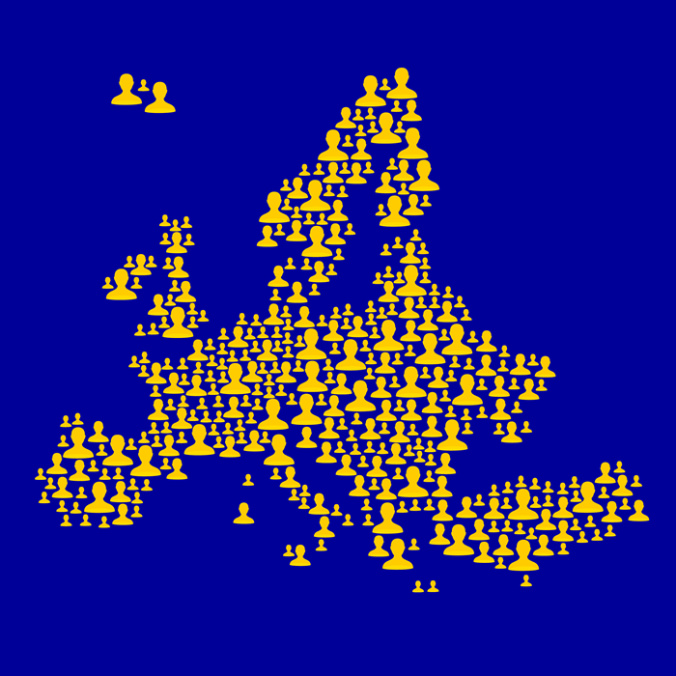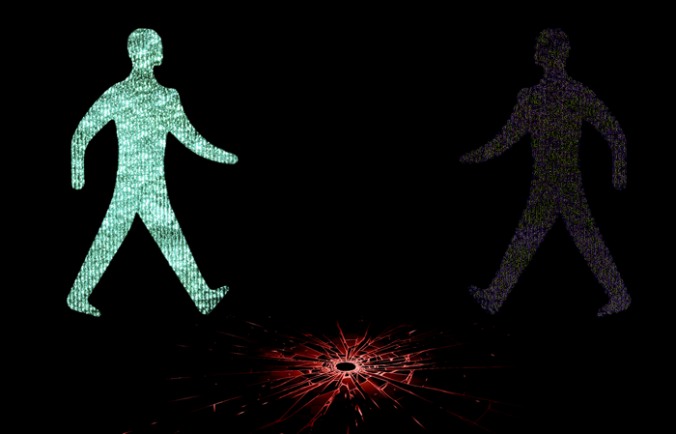 Only when the mirror is broken from both sides do ethics and otherness rush forward to greet each other.
Only when the mirror is broken from both sides do ethics and otherness rush forward to greet each other.
Let us reflect for a moment on Silvia Benso’s work, but in conjunction with Levinas’.
I think it’s safe to say that Benso offers a sympathetic postulation of Levinas’ thoughts on the il y a. However, instead of images of night, insomnia, and the persecution of existence, a lighter side is developed that articulates a wakefulness filled with potential, where things become animated, vibrant, and present to us. Her innovations of touch, attention, tenderness, and festival can be seen as paths into this lighter, and more positive side to the il y a. Just as Derrida realised that Levinas couldn’t resist the ‘expectation of an expectation’, which ultimately determined the neutrality of the il y a into the form of an other as human and took him away from Blanchot, then so too does Benso have an ‘expectation of an expectation.’ But this time we are taken back towards Blanchot, albeit a lighter and more joyful version.
Benso’s expectation is that otherness does not have to be solely determined in one form: the human. By addressing and identifying the alterity (otherness) within things, as we have seen in post 33, as well as implicitly considering Levinas’ work on human ethics as descriptive rather than prescriptive, Benso actually aids the maintenance of neutrality that Blanchot sought for the il y a, which we observed in post 23. In no way, however, is Benso’s shift one that rejects Levinas’ work. The multiplicity of the otherness given by Benso’s work is still grounded in the potential for an ethical relation, a relation that is first made manifest by Levinas. So Levinas, as far as ethics are concerned, remains king of the hill and the undisputed heavyweight champion of the world. Or, does he?

Simon Critchley takes a friendly but critical look at Levinas and asks, “Why should the discovery of alterity necessitate ethics?”1 Going deeper into the vein of his criticism Critchley sets forth a concern that pulls at the fabric of Levinas’ logic:
“I can see why there has to be a radical alterity in the relation to the other and at the heart of the subject in order to avoid philosophies of totality, but to play devil’s advocate, I do not see why such alterity then receives the predicate ‘goodness’. Why does radical otherness have to be determined as good or evil in an absolute metaphysical sense? Could one – and this is the question motivating critique – accept Levinas’s quasi-phenomenological description of radical alterity whilst suspending or bracketing out their ethico – metaphysical consequences?”2
Levinas is up against the ropes here. Has Critchley just delivered a knockout punch that has the potential to cripple Levinas’ entire philosophy? If we are to help second Levinas, steady his nerves, and focus his concentration we need to do some work ourselves.

The answer to Critchley’s questions, whilst comprehending that there might be no apparent reason for a connection between alterity and ethics, ultimately rests in whether we can state that where there is alterity there is also ethics. This is our task, because referring back to Critchley; it does appear that Levinas is trying “to smuggle a metaphysical presupposition into a quasi-phenomenological description.”3
Fortunately, we have Benso in our corner. By looking at Benso’s work as well as Levinas’ it should be evident that a synthesis can be said to exist between the thing/face and the subject that conditions the manifestation of alterity. Let me explain. Alterity arises from the il y a as described by Levinas and Blanchot in terms of night etc. But it can also arise from touch, attention, tenderness, and festival where the subject (me or you) is shown to be positively at work and involved, in such a way as to present ourselves as receptive to alterity, rather than just overwhelmed by it. In making ourselves receptive to alterity, we relinquish our totalising vision and ontological rationale. Now this is important, because it is in this relinquishing that we discover the arrival of alterity and ethics in unison. The synthesis of thing/face with us occurs, yes, because of the alterity of the thing/face, however it also requires our openness in the manner Benso outlined with touch, attention, tenderness and festival. Without our openness there is no alterity. Another term for openness, of course, is ethical, and that is the Benso-Levinas ‘killer-blow’ to Critchley’s devil’s advocate position.

Another way to think about the Benso-Levinas pairing is that when we regard something, or someone, as merely an object we dismiss both any possible alterity and, at the same moment any possible ethical relation. The dead-eyed stare of the cold, calculating political candidate allows no room for otherness or ethics when they assess our worth in terms of ‘voter potential’. To the candidate our existence is rendered purely as an object. Our individual personality, thoughts, hopes, dreams and aspirations are all ignored or used as they further their own ends with our being. We become voter 345929 rather than anything approximating to the full complexity of the person we know ourselves to be: our alterity is obliterated by their totalizing gaze just as surely as any possible ethical behaviour emanating from them. In their objectifying/totalising of us alterity and ethics are equally eviscerated. Conversely, when something, or someone, can be said to have alterity we should realise that an ethical relation also exists at that moment. All of which, I hope to have made clear, means that we can state when there is otherness there is also ethics. The two come hand in hand, but let us not forget that it took Benso’s work to help Levinas out of this sticky position and us to see the coupling of otherness and ethics.

In some ways we could pause here and reflect solely on what we have understood so far. However, as you can probably guess from the text flowing onwards this is not going to be the case. Instead, I want to spend a bit of time trying to understand why Levinas stuck to his guns and manoeuvred himself so dangerously into Critchley’s friendly but almost game ending critique.
What we have to remember is that Levinas’ philosophy was predicated upon a hard-nosed version of individual responsibility. In fact it could be argued that the necessity of having responsibility as ‘first philosophy’ seemed to guide Levinas’ thoughts through the realisation of the il y a directly into the face of another human. So what was going on then for Levinas? Why, in Derrida’s phrase, did he have ‘expectation of an expectation’ – the drive to give the il y a an anthropocentric base?
To answer this we have to understand what Levinas lived through. If one gives even the least cursory glance at his biography it becomes obvious that his defining moment was World War II. He was a Lithuanian Jewish philosopher living in France, conscripted to military service, who became a prisoner of war upon the German invasion of France. In addition, his family in Lithuania were also killed in the Holocaust. Consequently, it is no great leap to imagine that Levinas was very probably motivated by both personal and professional desperation to realign humanity.

The answer lay in replacing the guilty philosophy of ontology which led to the atrocities of war and genocide, for Levinas, with a purer form of philosophy. And, any such new philosophy had to be capable of yielding an unquestionable presence that could pump the blood back into the collapsed and distended arteries of horrified and mutilated nations. Consequently, only an ethics of responsibility for the other, prior to all other philosophies, could provide such a transfusion for Levinas. Hence the ‘expectation of an expectation’ became the one true ‘life source’, and effectively eliminated all other contenders for alterity and determined the Other as human because, the path to the human other necessitated no deviation or distraction to ensure that the ultimate objective was met: a sound philosophy that would not lead us again into the collapse of humanity and to genocide.
Quite whether this objective had been met, taken for granted, or forgotten by the time that Benso enters the scene is beyond the current task of our research. However, what is certain is that Benso’s work broadens Levinas’ objective to encompass a wider range of alterity so that otherness can be discovered outside the human face. Moreover, at the same time, her work continues Levinas’ marriage of ethics and otherness by revealing their unification in all the latter’s forms (such as touch, attention, tenderness and festival). Such unification only becomes evident, and Critchley’s reservations as to Levinas’ ‘smuggling’ answered, after Benso’s work introduces such other forms, because only then can we see how the subject’s questioning of the mode of being of things impacts upon the presence of otherness in the first place. This is not to dismiss Levinas’ work on the face as erroneous, in that he insisted that the face and hence responsibility came from outside of the subject, but to recognise that this was the exemplary but not necessarily definitive model, and that the subject can have a role in the manifestation of alterity.

Again, this is important because strict Levinasian scholars would possibly seek to argue here and insist that one of the key tenets of Levinas’ philosophy has been ruptured. Personally, I like to see Benso’s work complementing Levinas and helping him out of such sticky corners as laid on by the likes of Critchley and possibly others. However, the strict scholars would probably like to say that the whole drive of Levinas’ thoughts is based upon otherness presenting itself to the subject no matter whether the subject is open to such otherness or not. Such strictness of course gives Levinas power in one sense in that a subject can never avoid responsibility for the other by claiming to be unaware or not noticing the otherness of the other. In another sense, though, as Critchley makes clear, it feels somewhat as if Levinas has conjured ethics from a “quasi-phenomenological description of radical alterity”. The first sense, we can see now, had to be present for Levinas because he wanted to shore up any possibility of a future holocaust where people ignore their own humanity by treating others as objects and ultimately killing them. So, on his own against such as critiques as Critchley’s, Levinas can be found wanting in terms of philosophical rigour. However, as we can see Benso steps in to aid him in his hour of need. Maybe, though, we need to reflect on her assistance further to see a little deeper into how she rescued Levinas from Crtichley’s critique?
To look that bit deeper we need to view the matter from a different perspective. The problem, which I believe, Benso ultimately helps Levinas to overcome can perhaps be held more firmly in our grasp when we bring back F. Mai Owens ‘solitary’ individual in a state of self-absorption, within their mirror-lined globe, as first seen in post 25. Can it be conceived, even within Levinas’ strict system, that a human face can be presented to this ‘solitary’ individual and that, because of the way that individual questions the mode of being of things, a Levinasian ‘face’ might not actually appear? Instead an object could appear which has eyes, a nose, rouged checks and a red lipstick smile.

At this point, it should be noted that the force which Levinas wished to bestow upon the notion of the ‘face,’ as that before which we encounter an unavoidable responsibility, is not diminished by the example of the ‘solitary’ individual because the Levinasian ‘face’ has as yet not appeared. And, the reason it has not appeared is because the ‘solitary’ individual objectified what they saw and effectively blocked the Levinasian ‘face’. A Levinasian ‘face’ within that encounter does not yet exist; instead, an object does and will continue to do so until something shifts in the questioning of the mode of being of things within the subject, the individual themselves.

In addition, before any such ‘shift’, the ‘solitary’ individual as well as blindly passing by otherness also blindly passes by ethics. If one is locked in one’s own ‘mirror-lined’ world then one cannot be said to be ethical, if by being ethical we take action to be based on needs that aren’t one’s own.
Only when the mirror is broken from both sides do ethics and otherness rush forward to greet each other.

Effectively, then, by introducing ways in which the subject can be open, by breaking the mirror from the subject’s side through touch, tenderness, attention and festival, Benso’s work demonstrates not only the unity of otherness and ethics, but also the difficulty in realistically separating the action of the subject from the ‘face’ of the other when moments of otherness and ethics can be said to be made manifest. The manifestation appears to require both the subject and the ‘face,’ contrary to Levinas and an indecisive Heidegger on this issue. Through relinquishing the totalising gaze – the mirror lined perspective – and by adopting the open approaches touch, tenderness, attention and festival we become ethical. In our openness, as described by Benso, we become ethical.
So, rather than possibly undermining Levinas, a possible accusation from the strict Levinasian scholars, Benso, I believe, strengthens his project by giving a strong ethical stance through the addition of touch, tenderness, attention and festival and taking his thoughts past the limits of their original ‘humanitarian’ or anthropocentric objective towards a more encompassing vision. Of course, it can be said that within Existence and Existents, when Levinas first discovered alterity, he did seem to have a broader view of alterity. However, as we know, in his later texts he narrowed his field of vision in order to reveal a purely ‘humanitarian’ ethics. One point being, that such ‘narrowing’ overshadowed other potential questions or options for alterity within Existence and Existents: alterity within abstract art being one such option, as we saw in post 31. The second point being that his postulation of ethics needed beefing up by Benso to avoid being flattened entirely by the likes of Critchley’s sound devil’s advocate critique.

Well, maybe we should stop here for the moment. After all we have boxed with Critchley, thought about philosophy’s impact on the Holocaust, examined Benso’s strengthening of Levinasian thought and not even paused to look at any art! So, it’s fair to say that we have done some work. However, the real point is that we need to do more work with each other, a la Benso’s ideas, in order to not block the ‘face’ of the other person in revealing their otherness and our ethical responsibility. So, work on, people, work on!






